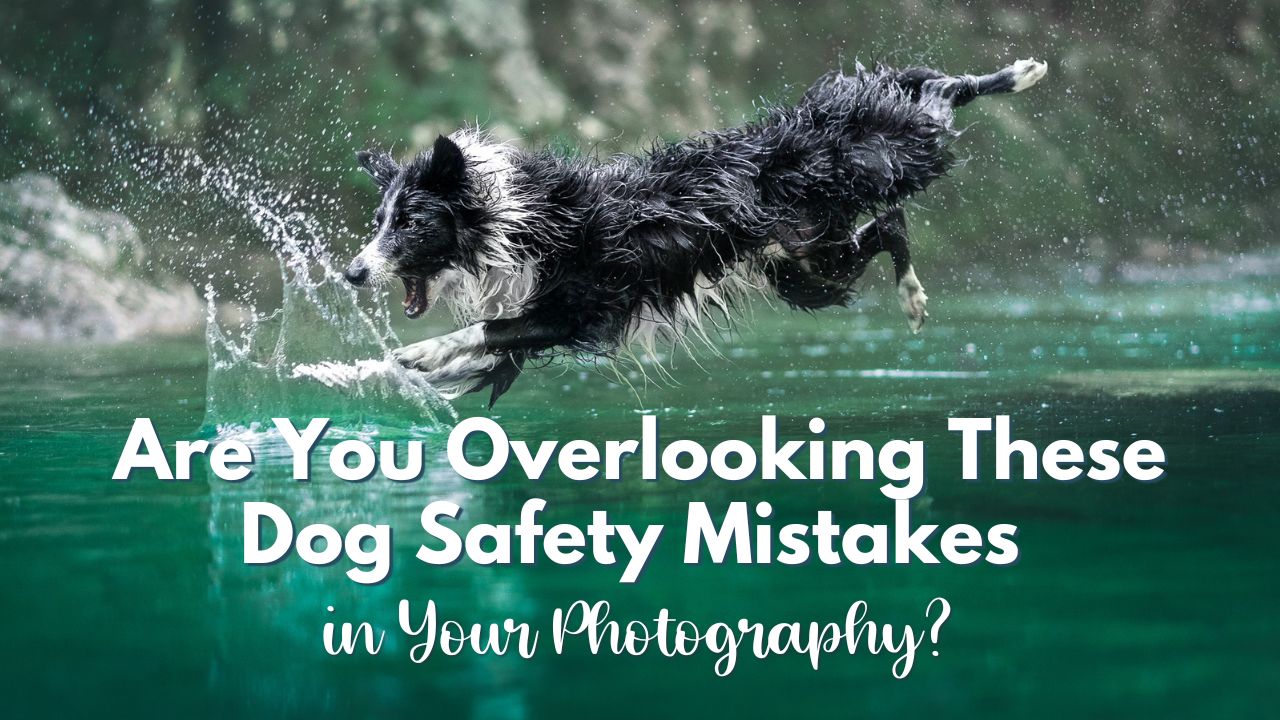As pet photographers, we put so much thought into choosing the perfect location, light, and angles to create stunning dog portraits. But how often do we stop to consider the safety and comfort of our dog models?
🔎 Are you unknowingly pushing dogs too hard during photoshoots?
If you’ve ever asked yourself any of these questions, this post is for you:
✔ “Should I ask dogs to jump for action shots?”
✔ “How do I pose a puppy safely in dog photography?”
✔ “What’s the best way to photograph senior dogs?”
✔ “How can I tell if a dog is getting tired during a shoot?”
We spend hours learning about composition and editing—but how much time do we spend understanding the physical impact of dog modeling?
Most of us assume that if a dog can do something, they should do it. But just because a dog can jump over a log, balance on a stump, or hold a pose for minutes at a time, doesn’t mean they should.
➡️ In this guide, we’ll cover five common mistakes photographers make when posing and photographing dogs—plus how to keep your models safe, comfortable, and happy.
🔎 A Quick Disclaimer: Every Dog is Different
Before we dive into the tips, it’s important to remember that every dog is unique.
The signs of fatigue, discomfort, or pain depend on the individual dog, their natural tendencies, and their training level.
- Some dogs, like Journey, naturally look away a lot during photoshoots. For Journey, he likes to watch the world around him, and doesn’t like the pressure of being asked constantly to look at the camera.
- Some dogs are naturally fidgety or excitable, and frequent readjusting may just be their personality rather than a sign of discomfort.
- A dog that hesitates to pose may be untrained or distracted, rather than in pain.
📌 The key takeaway? Know what’s normal for the dog in front of you.
If something seems off, don’t ignore it. And if in doubt, reach out to a professional like Frey—he can help assess your dog and make sure there’s no underlying pain you might be missing.
Honestly? I think that every dog could benefit from regular, structured fitness training, overseen by a professional who can check form and give feedback. I thought I was doing it right for YEARS—until I learned I wasn’t.
1. Repeating the Same Motion Too Many Times
🐕 “Just one more jump for safety!”
🐕 “I think we can get an even better angle—one more try!”
It’s a habit we all have. When we’re trying to get the perfect shot, we repeat movements over and over, asking dogs to jump, run, balance, or hold a pose just a little longer.
The problem? Even if a dog is fit, repetition can quickly lead to fatigue and strain.
A Personal Story: How Journey’s Injury Changed My Perspective
Most of you know Journey, who I considered to be an extremely fit agility dog. We walked a lot, every day, and did “fitness training” a few times a week. I wouldn’t have thought twice about jumping him over a log multiple times in succession—because I thought he was strong enough to handle it.
Then he got injured.
Not in agility. Not from slipping. Not from any obvious trauma. There were a number of factors that contributed to his injury, with the umbrella cause being that he wasn’t using his body well.
Through his rehab, I’ve learned that most of us severely overestimate how fit our dogs are. If even a well-conditioned agility dog wasn’t as fit as I thought (despite doing regular exercises with him – not realising the form was wrong, the exercises were wrong, the execution was wrong), what does that say about the average pet dog model?
🐾 How to Prevent This:
✔ Limit repetitive movements. If a dog has already done a few jumps, let’s find a new angle or pose instead.
✔ Watch for early fatigue signs (see mistake #2!).
✔ Be mindful of how a dog lands. If you’re asking them to jump, is the landing area soft, even, non-slip, and free from hazards like rocks or sticks?

Nobody is saying you can’t get the dog to jump, jump up, do tricks, etc… just be very mindful that the treshold for how many repetitions is suitable for them to do may be MUCH lower than you’d think. I recently photographed a dog and we got it to jump up three times. The dog probably could have done more, but to me it was already showing subtle signs of fatigue, so I called it it that point.
2. Ignoring Subtle Signs of Discomfort or Fatigue
We often think dogs will show us clear signs of pain—limping, whining, or refusing to move. But most of the time, dogs often don’t show discomfort until they’re in significant pain.
Signs of Fatigue & Discomfort in Dog Models:
-
- Rounding or roaching of the back → This can indicate fatigue, discomfort, or joint strain.
-
- Weight shifting from foot to foot → The dog is trying to relieve pressure or redistribute weight.
-
- Hesitation before holding a pose → They might be stiff, uncomfortable, or unsure.
-
- Frequent readjusting → A dog that keeps shifting positions might be struggling to hold a pose.
📸 We assume a dog is being “stubborn” when they stop listening. But what if they’re actually too tired to continue?
3. Expecting Perfect Focus for Too Long
Mental fatigue is real. Just like people, dogs have a limit to their focus.
Even highly trained working dogs need rest breaks. And yet, during a shoot, we sometimes expect pet dogs to stay locked in for extended periods of time.
📌 The key takeaway? If a dog stops listening, they might not be “disobedient”—they might just be mentally exhausted.
4. Overlooking Special Considerations for Senior Dogs
📉 Did you know one of the most common reasons senior dogs are euthanized is because of falls?
Falls can be catastrophic for older dogs. If a senior dog falls from a height, they may not be able to get back up—or they may suffer an injury that they can’t recover from due to muscle loss.
How to Keep Senior Dogs Safe in Photography:
-
- Avoid high platforms. If you must place them somewhere elevated, always lift them on and off.
-
- Look for soft ground. Seniors are more prone to slipping—avoid wet rocks, icy surfaces, or slick wooden bridges.
-
- Watch for signs of pain. Seniors are more likely to be stiff and sore, even if they don’t show obvious discomfort. Be conscious of how far they have to walk during the shoot, find locations close to parking lots if needed.
5. Misunderstanding Puppy Energy & Safety Risks
Puppies don’t just get tired—they get reckless.
Ever seen an overtired child go on a rampage, running around wildly before they suddenly crash? Puppies do the same thing.
As Frey says:
🗣 “When puppies get fatigued, they go overboard. They have no sense of self-preservation, so if they’re tired and start zooming around—it’s a recipe for disaster.”
How to Keep Puppies Safe in Photoshoots:
-
- NEVER ask a puppy to jump. Even a single jump could cause joint damage.
-
- Pick up puppies for elevated shots. Don’t ask them to jump onto a platform—lift them on and off. If they’re likely to leap off? Don’t put them up there.
-
- Keep sessions short. If you’re working with a puppy, expect to finish quickly.
What’s Next? Learn More From a Canine Physio!
This is just the beginning of the conversation. Frey Jun (Certified Canine Physio, CCRP, CCFT) has worked with high-performance working dogs, service dogs, and canine athletes—including Journey’s rehab.
📅 Join us on March 30th for an exclusive live webinar on:
✔ Recognizing fatigue & discomfort in dog models
✔ The hidden dangers in posing, balancing, and jumping
✔ How to work with puppies, seniors, and dogs with special needs—safely





